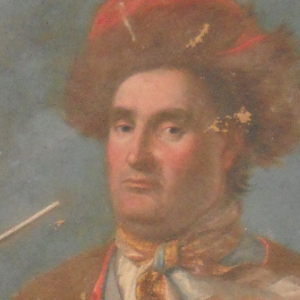During the Counter-reformation, a period of heightened moralism and in which Giovanni Andrea I was born, the figure of Prometheus was often used as a symbol for the passion of the Christ. According to the myth, the hero fell foul of Jupiter’s ire for his constant helping of humanity. The God of the Gods decide to punish him by subjecting him to a terrible torture: he was bound to a rock where every day an eagle would come to devour his liver, before being reborn during the night so as to suffer the same fate the following day. In the decoration of the walls, by Marcello Sparzo, we can see Mercury stooping to bind Prometheus’ powerful figure to the rock. These days the space is used as a breakfast room by the owners of the palazzo. To the left of the entrance there are four panels from the seventeenth century, made of painted silk and of a vaguely oriental origin. These represent an early example of the taste for Chinese-influenced objects that was common in Europe at that time. The ornamental tiling displayed on the seventeenth century console table immediately below these panels is also of value. The cafetiere from the eighteenth century is notable for its decoration of flowers, leaves, spirals, insects and scattered birds. The second piece, going back to the start of the nineteenth century, is a ‘puzzle jug’, called “drink if you can”: in the base there is a small spout, and by covering this hole with a finger, the liquid flows out of the mouthpiece and pours into the cup from which it is then possible to drink from. The set of green couches and armchairs with velvet upholstery may be attributable to the Genoese baroque style, and these are worthy of note for their decorative floral motifs and for their feet which face inwards. On the walls there are appliques, showing a series of fourteen ornamental vases used to store food, as the odd and still legible writing on them attests: “saffron, conserve of quince, sarsaparilla”. The trademark beneath identifies them as being from the noted manufacturer, Chiodo from Savona. The room also houses some interesting paintings: two passages from the Old Testament, The struggle between Jacob and the angel, and Samson and the lion, which were approached in a theoretical manner by Carlo Antonio Tavella and his circle. He was a Milanese painter and was long active in Genoa, where he was responsible for the introduction of the vivid styles of Poussin and Salvator Rosa. The marina with lighthouse and landing jetty was recently cleaned and shows a panorama of the sea, from which some of the naval technology of the time can be seen.

Due to its poor condition, this painting was recently restored, giving life back to the canvas. The main character in the painting is shown smoking a very long pipe. He is dressed in a red jacket with large cuffs, a red beret and a silk neckerchief . To the left, a Genoese flag is fluttering. In the background, one can see the sea, from which a rocky coast emerges on which there is the lighthouse of Genoa. The iconography is unusual and has been presumed to have the aim of glorifying the role of the merchant, while the author was probably a Genoese artist, active between the end of the sixteenth and start of the seventeenth centuries.